Considered one of our most delicious bush tucker plants, midyim berry is an attractive small spreading shrub famed for its gorgeous white and purple-speckled berries which are a popular traditional bush food.
Featuring dainty elliptical glossy-green leaves and small white star-shaped flowers that ripen into sweet edible berries in autumn, the plant also has a functional low-spreading form that can be pruned into a hedge or left to grow wild in rockeries or as understory planting.
Here is your extensive guide to growing and caring for this highly sought-after bush tucker.
More...
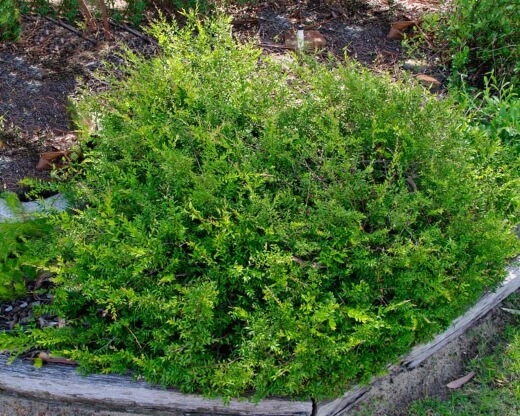
Source: GardensOnline
Family: | Myrtaceae |
|---|---|
Genus: | Austromyrtus |
Species: | A. dulcis |
Common Names: | Midyim berry, midgen berry, silky myrtle |
Location: | Outdoor |
Type: | Perennial shrub |
Growth: | 0.5 to 1 metre tall, 1.5 metres wide |
Sun requirements: | Full sun to part shade |
Foliage Colour: | Green |
Flower Colour: | White |
Flowering: | Summer |
Fruit: | White speckled edible berries in autumn |
Maintenance level: | Low |
Poisonous for pets: | Non-toxic to cats and dogs |
Introducing the Midyim Berry
Botanically named Austromyrtus dulcis where ‘dulcis’ means sweet, referring to the plump sweetened berries, common names now also include midgen berry and silky myrtle.
The shrub is endemic to eastern Australia where it largely occurs in New South Wales and Queensland as a common understory plant in the heathlands and woodlands.
It thrives in cool, warm-temperate, subtropical and tropical climates, making it a perfect fit for most Australian gardens. Apart from its highly decorative blueberry-like fruits, this shrub also produces exciting new growth in a bold burgundy red that matures into dark green.
When grown with care, this plant can produce an abundance of berries and is considered an easy-to-grow bushfood with many delicious and nutritious culinary applications.
Within landscapes it can be used in a few decorative and functional ways as well so it is a great choice for any grower looking at establishing an edible shrub in their gardens.
Midgen Berry Plant Features and Applications
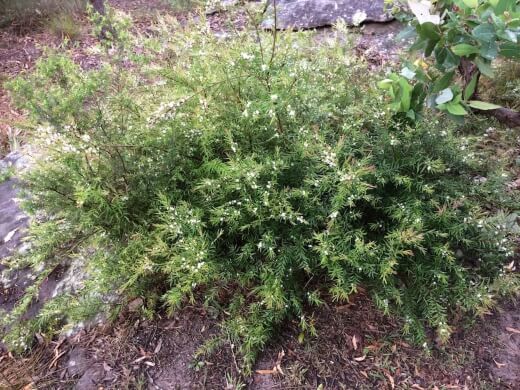
Source: small green things
When established in gardens, the shrub will normally grow at a moderate pace to around 0.5 to 1 metre tall and 1.5 metres wide. However, being so responsive to pruning, size and shape can be closely controlled by growers.
The plant is very hardy and adjustable, being able to grow well in many different soils and climate conditions. The only caveat is that it can sometimes be a hard species to find.
Common landscaping applications include:
- Low-growing hedge
- Decorative shrub for borders or rockeries
(Check out our extensive guide on how to set up rock garden) - Potted garden plant
- Perfect for coastal gardens as long as it is sheltered from strong salty winds
- Ornamental gap filling in beds
The flowers and fruits will be highly attractive to local birds, bees and butterflies. Midyim berries will fruit from year one onwards.
Growing Midyim Berries in Australia
This native shrub is best propagated using seeds or cuttings. It is considered easy to propagate so follow our simple steps here to grow your plant.
Nursery plants can also be a great option if you can find one as they will establish themselves quickly so you can take advantage of the shrub's influence in your natural spaces and its delicious fruits far sooner.
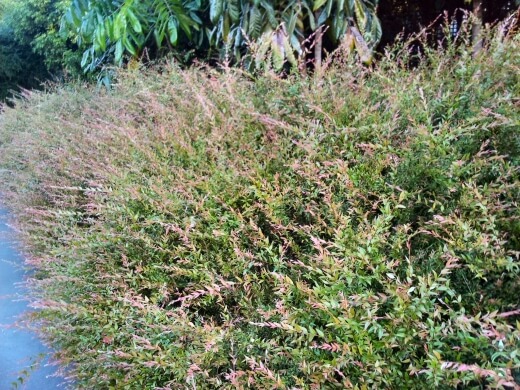
Source: Gardening With Angus
How to Grow Midgen Berry from Seeds
- Once the fruits have started to harden in late autumn, you can pick them to extract the seeds.
- Each berry should contain about 3 to 9 edible seeds that you can use to propagate.
- Remove the pulp from the seeds and set them aside. No seed scarification is required.
- Prepare seed trays or punnets with a quality seed-raising mix.
- Sow your seeds into the mix then water lightly.
- Keep the mix moist during the germination process and keep the seeds in a warm location with filtered light away from harsh direct light.
- Germination can occur within 4 to 6 weeks depending on the specific conditions.
- Allow seedlings to develop properly before transplanting into a larger container or outside.
Propagating Austromyrtus dulcis from Cuttings
- You can strike softwood or semi-hardwood cuttings.
- Using a sharpened and sterilised pair of secateurs or scissors, cut a healthy piece of plant stem away that has some foliage and leaf nodes.
- Remove most of the foliage from the cutting and set it aside.
- Prepare a well-draining container filled with a quality propagating mix. A combination of equal parts compost, peat and perlite can work well.
- Dip the ends of the cutting into some rooting hormone before planting.
- Place your cuttings firmly into the mix and water well.
- Position in a warm sheltered location that gets some indirect light.
- Keep the soil moist as the cutting develops new roots.
- Once rooted, allow the cutting to develop for longer until the roots have grown to a healthy size.
- Thereafter, you can transplant it into a larger container or straight into your garden bed.
Planting & Growing Conditions for Midyim Berry
This shrub doesn’t require much fuss when considering the ideal conditions for healthy growth. Overall, it is an adaptable native that can thrive in many different environments. However, for bountiful flowering and fruiting, here are its preferred conditions.
Ideal Sunlight
The shrub can grow in full sun to part shade. Fruiting and flowering will be more prolific outside of heavily shaded positions. In warm climates, some afternoon shade will be appreciated but in cooler climates, more full sun will be best.
Best Soil for Midgen Berry
As mentioned, midgen berry is adaptable to most soils provided the soil is well-draining at all times. It is considered best practice to enrich your soil by digging in some compost and well-rotted manure to ensure proper nutrient intake.
Naturally, this plant does grow in sandy soils so try to prevent planting it in heavy clay-based soils unless you improve aeration and breathability beforehand.
For potted specimens, using a quality potting mix should be perfect.
Quick Midyim Berry Planting Tips for Gardens
- Dig your planting hole so that it is about twice as wide and to the same depth as the root ball of your plant.
- Gently remove your plant from its current container then lightly tousle the roots loose to remove some of the old soil.
- Place it in the centre of your planting hole and backfill with soil.
- Lightly firm the soil around the base so that the plant is sitting snug.
- Water well after planting.
- For hedges or mass plantings, space each plant roughly 50cm to 1m apart for the best results.
- Hedge planting can often be made easier by digging trenches rather than individual holes.
Caring for Midyim Berry
In cool climates, it is best to plant Austromyrtus dulcis in a sheltered position under trees or among other shrubs for protection against frost. Apart from that, the plant requires only basic care to thrive in gardens.
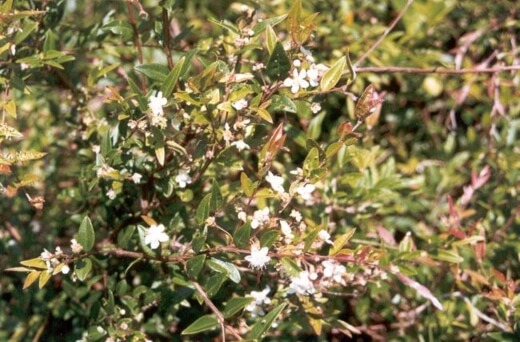
Source: Queensland Government
Watering Midgen Berry
The plant will need regular waterings when young and developing. Once established after about 12 to 14 months, it will become fairly drought-tolerant where waterings can be done less frequently, about twice per week.
In general, the plant will respond well to regular water during flowering and fruiting in the growing seasons.
Pruning Midgen Berry
It is best to prune lightly after fruiting to continuously encourage a bushy habit. Tip-pruning new shoots quarterly can also help to keep the plant compact and encourage fruitful harvests.
For hedge pruning, trim as needed to maintain density and shapeliness. Expand your knowledge on pruning Australian native plants here.
Fertilising Austromyrtus dulcis
Some may prefer not to fertilise their plant, especially if the berries will be consumed frequently. As this plant doesn’t necessarily need fertiliser to thrive, you can opt for an eco-friendlier approach where fewer chemicals are used.
However, in certain climates, fertiliser can help to boost the plant's production of flowers and fruits. Use a native-specific fertiliser during the active seasons when the plant begins flowering and fruiting.
Mulching Needs
In summer, add a layer of organic mulch around the base of the plant to help conserve soil moisture and suppress weeds.
Midyim Berry Bush Tucker Guide for Home Use
The decorative melt-in-your-mouth berries are sweet and aromatic with pleasant spicy notes of pepper and ginger. They are considered some of our tastiest bush foods and can be used in many ways within the kitchen.
Once ripened, the berries look similar to blueberries and feature a crunchy fresh texture. The berries will be ready for harvesting from year one onwards where the first harvest may be minimal but will increase as the plant matures.
Harvesting Midgen Berry
- Harvest in late summer to autumn once the berries are ripe and soft.
- To promote good harvests, keep the plant well fed and watered throughout flowering and fruiting.
- After fertilising, delay harvesting for a couple of days and rinse berries well before consuming them.
- Birds may be keen on eating the berries as well so plant a few shrubs to share or use some bird netting to protect your yields.
- To harvest, simply pick the berries straight from the shrub.
- Harvests do not store for long so be sure to use the berries as soon as possible after picking.
How to Use Midyim Berry
- Each berry will contain about 3 to 9 edible seeds.
- The berries are a great source of iron, calcium and dietary fibre.
- The berries can be eaten raw or used as tasty additions in many culinary dishes.
- Use the sweet berries as additions to savoury salads, desserts, preserves, jams or tossed with yoghurt.
Be sure to check online for recipes that may interest you and don’t be scared to get a little creative with these sweet and aromatic berries.
Possible Midyim Berry Pests & Diseases
These plants hardly suffer from any pest or disease issues which is fantastic for those who want to minimise their environmental impact by avoiding chemical sprays and fertilisers. However, in rare situations, this plant can suffer from a family disease known as myrtle rust.
Myrtle Rust
Known as Austropuccinia psidii, this deadly fungal disease affects many of the plants in the Myrtaceae family. The spores have distinctive yellow and orange hues occasionally enclosed by purplish rings.
This rust is normally located on new shoots, leaves, buds and fruits. Unfortunately, there is no sure-fire way to get rid of this disease and research is still being done to try to find a cure.
For small infections, you can cut away any affected foliage to stop the spread. Be sure to wear protective gear and dispose of damaged foliage off-property.
You can also consider applying a fungicide or neem oil spray to help lessen the infection. In severe cases, your plant will need to be removed and discarded to stop the disease from spreading to other vegetation.
Midyim Berry Frequently Asked Questions
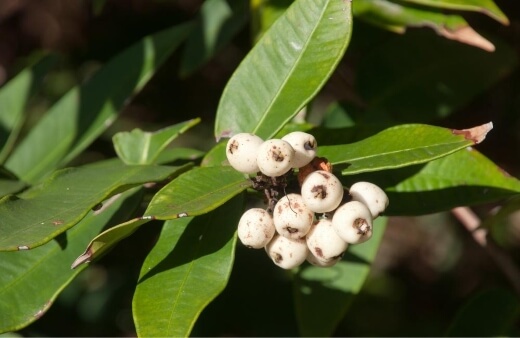
Why are my midyim berry leaves becoming pale?
This could indicate that your soil is too lime-heavy. These shrubs prefer a neutral to slightly acidic pH level.
My midyim berry plant is producing lots of leaves but no flowers or fruits?
This is most likely due to the plant not getting enough sunlight. Light is imperative for these plants to produce flowers which then turn into fruits.
Try moving your plant to a sunnier spot to help encourage more life. Alternatively, your fertiliser could be wrong. Try to use fertilisers with low-nitrogen content.
Why is my midyim berry shrub dying even though I water it every day?
Once established, this plant is quite drought-tolerant so if you’re watering daily, the plant is likely being overwatered which will severely stunt growth and the overall appeal.
Even in hot conditions, you may only need to water about twice per week. For potted plants, ensure good drainage and try repotting into a fresh potting mix.
Interested in also establishing other bush tuckers that produce delicious fruits? Check out our in-depth guides below for reference:
Enjoy Melt-In-Your Mouth Berries & an Excellent Shrub with Midyim Berry
It’s easy to understand why this native shrub has garnered such a reputation throughout Australia with its burgundy new growth that matures to glossy green, its dainty white fluffy flowers and highly decorative and delicious berries.
This plant is an excellent choice for those who are looking at establishing a renowned bush tucker or those who simply want to take advantage of the plant’s fantastic shrub qualities within landscapes.
Midyim berry allows you to enjoy its altogether stunning features while being a low-maintenance addition to the garden.
Published on August 12, 2022 by Nathan Schwartz
Last Updated on March 25, 2024




